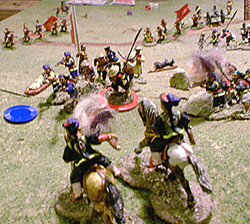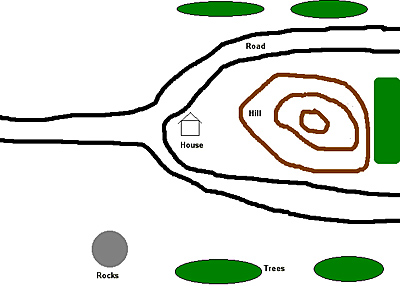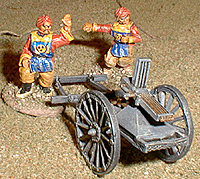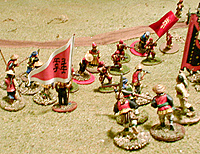
Most colonial enthusiasts are familiar with Mark Fastoso's Colonial Campaigns Scenario books, and the entertaining battles he hosts at the HMGS conventions. They feature excellent terrain, beautiful figures, interesting historical background, and an exciting game. Unfortunately his games fill up quickly, so this year at Cold Wars 2003 I pre-registered for his "Boxer Revenge" scenario. The scenario is based on historical events from 1900. The Imperial army has captured six Boxer leaders and is escorting them to the provincial capitol for execution. If the leaders are killed the Boxer movement is over in this province. The Boxers decide to attempt a rescue. They have ten turns to rescue three of the six leaders and get them safely off the board. The Imperials must move at least four of the prisoners off the far edge of the board to score a victory. Any other result is a draw.
The rules used were The Sword and the Flame. The battlefield featured a road that forked, passing on either side of a large hill before exiting the far side. Scattered woods were on the edges of both sides of the battlefield. A house was located at the road fork, and a small field of rocks completed the terrain. The Imperial side had several rifle units, a Gatling gun, a cannon, two cavalry figures, and a mounted leader. The Boxers had ten units (no more than two muskets in each unit) and three leaders. I was put in command of three units of Boxers.
 I met with the other two Boxer
commanders to discuss strategy. I'm convinced that we lost the
battle when we failed to appoint an overall commander, or at least
settle on one clear strategy. Like the leaderless rabble that
we were each commander deployed his troops as he pleased. I deployed
as far forward as possible. My thinking was that if we fought
the battle there the Imperials would be unlikely to make it across
the board. I also didn't want to cross a lot of open ground, or
give them an opportunity to sniff out an ambush farther down the
road. The other Boxer units were scattered over the rest of the
board, including at least one unit at the very back edge of the
board. This was not a recipe for success.
I met with the other two Boxer
commanders to discuss strategy. I'm convinced that we lost the
battle when we failed to appoint an overall commander, or at least
settle on one clear strategy. Like the leaderless rabble that
we were each commander deployed his troops as he pleased. I deployed
as far forward as possible. My thinking was that if we fought
the battle there the Imperials would be unlikely to make it across
the board. I also didn't want to cross a lot of open ground, or
give them an opportunity to sniff out an ambush farther down the
road. The other Boxer units were scattered over the rest of the
board, including at least one unit at the very back edge of the
board. This was not a recipe for success.
On the first turn I was pleased to see that the Imperials had spread the prisoners among their various infantry units. This would make it much easier to free them. The cavalry spotted my unit in the rocks, and two Imperial infantry units and the Gatling gun moved to attack them. I moved my other two units out of the woods to support the men in the rocks. On the second turn an Imperial unit charged the men in the rocks. I successfully evaded, moving them onto the flank, and routed the Imperials with a countercharge of my own. I was disappointed to learn that routing units take their prisoners with them. This was going to be harder than I first thought.
 On the next turn I charged an
Imperial unit holding two prisoners, they evaded, but were then
hit by another of my units. We won the melee and gained control
of both prisoners. Things were looking up. It also helped that
my opponent couldn't get his Gatling gun to fire. It jammed the
first four times he tried to fire it, and five of the first six
tries. Aren't the Chinese supposed to be good with gunpowder?
On the next two turns I moved my prisoners toward the table edge
while looking for a chance to grab a third. The Imperials sent
three infantry units in pursuit, along with the cavalry and their
commander. The infantry were kind enough to bring along another
prisoner, giving me an opportunity to rescue him. By this time
the rest of the Imperial force had advanced to the fork in the
road where they engaged Boxers hidden in the house and woods.
The Boxers were driven from the house, but the cannon was overrun.
Unfortunately my fellow Boxer commanders were unable to free a
prisoner, and suffered heavy casualties in their attacks.
On the next turn I charged an
Imperial unit holding two prisoners, they evaded, but were then
hit by another of my units. We won the melee and gained control
of both prisoners. Things were looking up. It also helped that
my opponent couldn't get his Gatling gun to fire. It jammed the
first four times he tried to fire it, and five of the first six
tries. Aren't the Chinese supposed to be good with gunpowder?
On the next two turns I moved my prisoners toward the table edge
while looking for a chance to grab a third. The Imperials sent
three infantry units in pursuit, along with the cavalry and their
commander. The infantry were kind enough to bring along another
prisoner, giving me an opportunity to rescue him. By this time
the rest of the Imperial force had advanced to the fork in the
road where they engaged Boxers hidden in the house and woods.
The Boxers were driven from the house, but the cannon was overrun.
Unfortunately my fellow Boxer commanders were unable to free a
prisoner, and suffered heavy casualties in their attacks.
My second move towards the table edge ended one inch short of safety. Only three of my eight men could get off the table, and you can't exit unless at least half can make it, so I was forced to stop at the edge. There I would remain for several agonizing turns, praying for my card to come up first. My prayers were not answered, and I had to fight a series of battles as my opponent charged with every available unit, and I used my other two units for spoiling attacks or counter charges. Fortunately my bad luck with cards was more than matched by my opponent's bad luck with dice. Time and time again his promising charges failed to close, or he lost the melee. At the end of the turn his routed units would stagger back, only to be rallied by the officer to charge in again next turn. Things always get strange when you're fighting right at the table edge.
While this swirling, chaotic battle was taking place we were desperately trying to free a third prisoner. The other Boxer commanders weren't having much luck. One of them was down to a single unit with only three figures. He tried and failed to free a prisoner. The other was frantically moving a fresh unit forward from the opposite end of the board, but it didn't look like it would be able to get into action in time. I got lucky on turn eight when an Imperial unit charged and left their prisoner in the hands of a few stragglers. I charged them and won the melee, freeing the prisoner with just two surviving Boxers. I was finally able to get the other two prisoners off the board, so the battle would hinge on whether we could get the third prisoner to safety.
 Up to this point in the battle
I believe I'd been tactically sound, but on turn nine I made a
costly blunder. An Imperial unit charged my two Boxers and their
prisoner. The next card was for the Boxers. I sent my fresh unit
in on a countercharge to help defend the prisoners. I realized
this was a mistake as soon as I'd done it. On the next Boxer card
I made my morale check and the two Boxers evaded the Imperial
charge, moving with their prisoner to the edge of the table (again
I was an inch short of getting away). The better move would have
been attempting the evade move first. If that succeeded I could
have used a normal move to send my fresh unit to defend the prisoner.
By doing it backwards I had left the prisoner vulnerable with
only two figures for protection. The Imperials moved their cavalry
and officer into position to charge on turn ten, leaving me at
the mercy of the fickle cards.
Up to this point in the battle
I believe I'd been tactically sound, but on turn nine I made a
costly blunder. An Imperial unit charged my two Boxers and their
prisoner. The next card was for the Boxers. I sent my fresh unit
in on a countercharge to help defend the prisoners. I realized
this was a mistake as soon as I'd done it. On the next Boxer card
I made my morale check and the two Boxers evaded the Imperial
charge, moving with their prisoner to the edge of the table (again
I was an inch short of getting away). The better move would have
been attempting the evade move first. If that succeeded I could
have used a normal move to send my fresh unit to defend the prisoner.
By doing it backwards I had left the prisoner vulnerable with
only two figures for protection. The Imperials moved their cavalry
and officer into position to charge on turn ten, leaving me at
the mercy of the fickle cards.
To the surprise of no one the first card went to the Imperials, so I wasn't able to escape. Even if we won the melee we wouldn't be able to move off the board this turn. In any event I failed my die roll and routed, handing the prisoner back to the Imperials. The battle ended in a draw. Despite a major strategic error at the start, and a costly tactical error at the end the Boxer's came close to winning the battle. Both sides played a good game, and everyone had fun.
Back to Table of Contents -- Junior General Report #2
Back to Junior General Report List of Issues
Back to MagWeb.com Magazine List
© Copyright 2003 by Matt Fritz.
This article appears in MagWeb.com (Magazine Web) on the Internet World Wide Web. Other articles covering military history and related topics are available at http://www.magweb.com